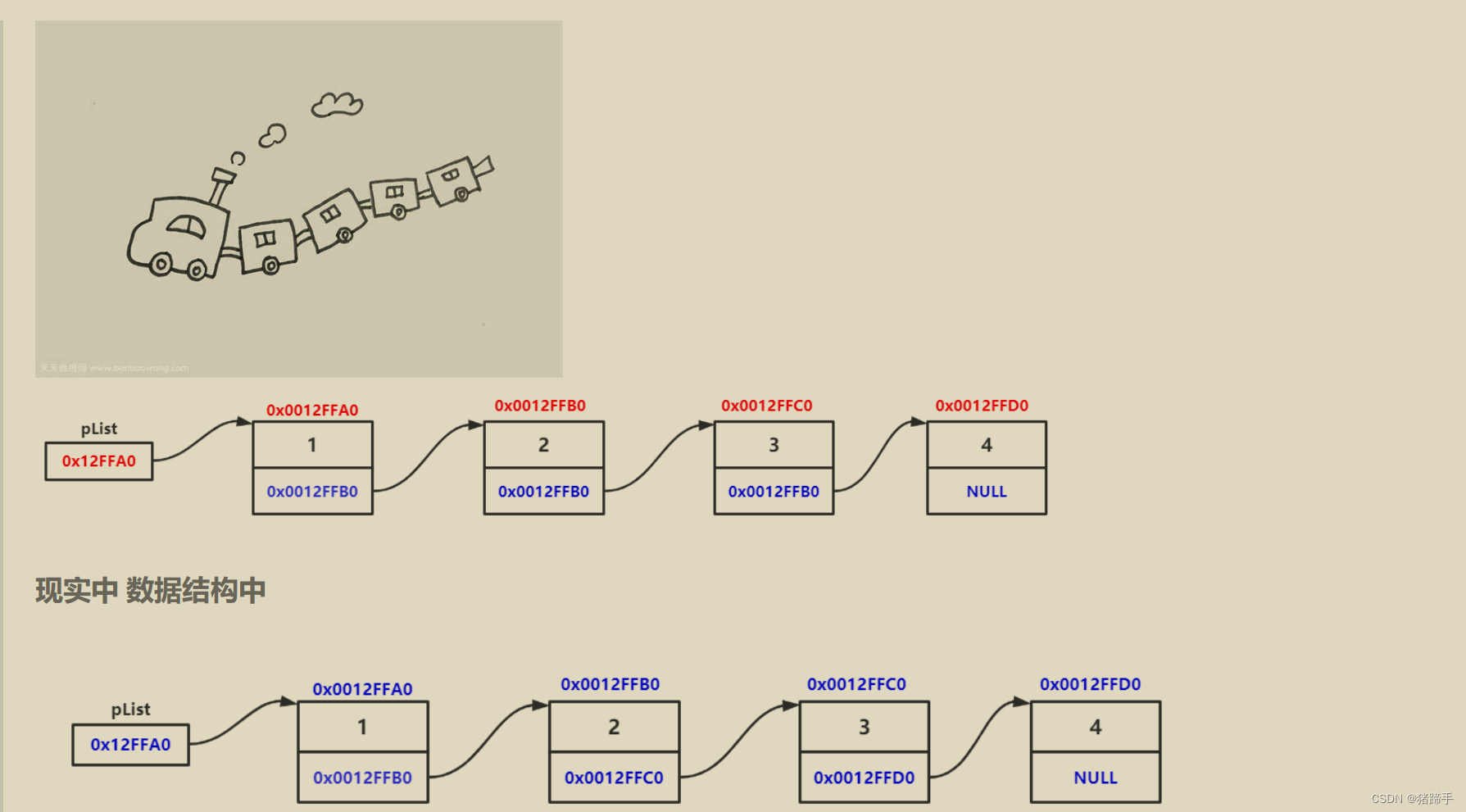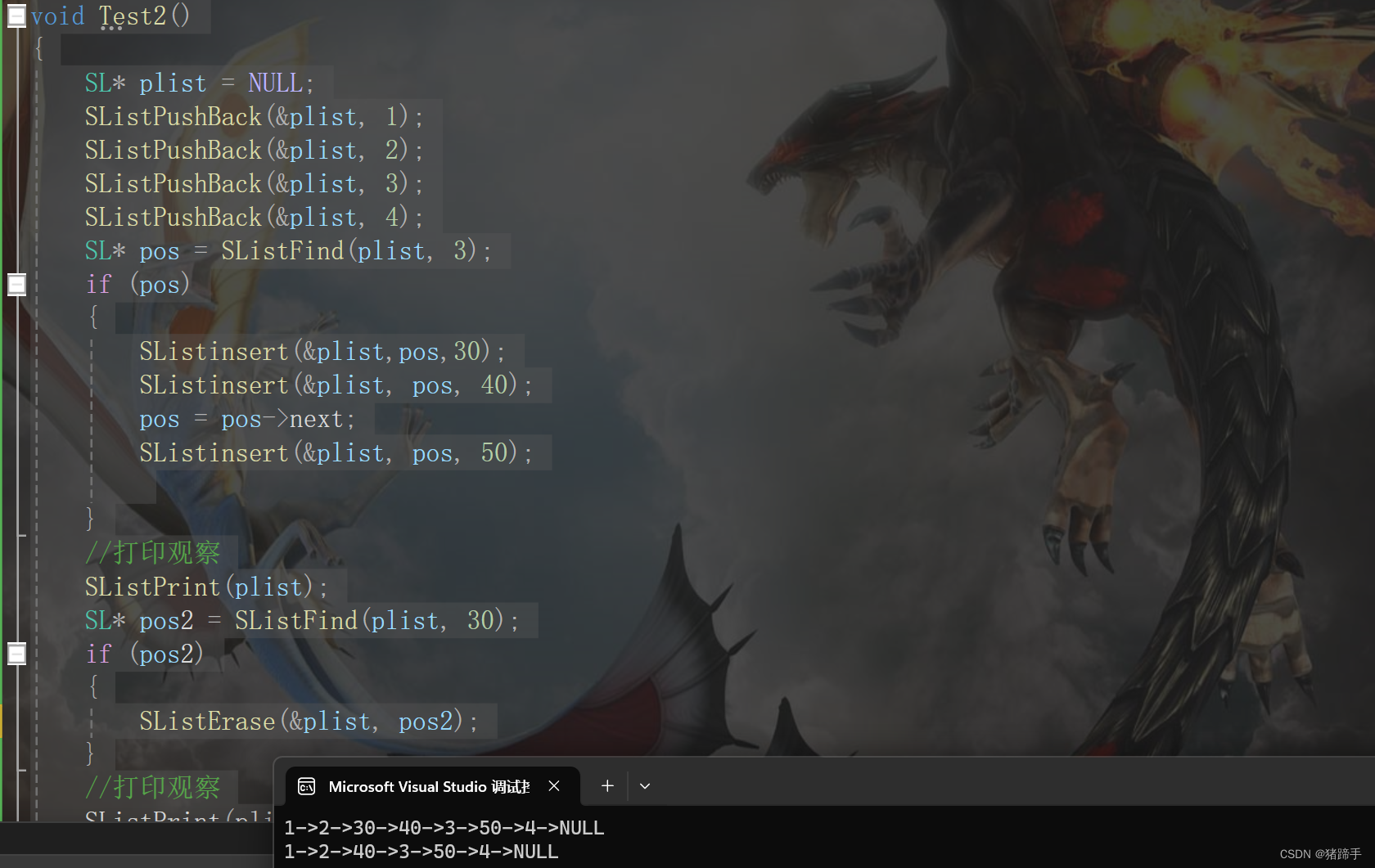数据结构之单链表(不带头单向非循环链表)
发布时间:2023年12月17日
一.引言
上一节我们学过了顺序表,那么我们想想顺序表有没有问题呢?我们来讨论顺序表的问题及思考。
顺序表问题:
1.中间/头部的插入删除,时间复杂度为O(N)
2. 增容需要申请新空间,拷贝数据,释放旧空间。会有不小的消耗。
3. 增容一般是呈2倍的增长,势必会有一定的空间浪费。例如当前容量为100,满了以后增容到
200,我们再继续插入了5个数据,后面没有数据插入了,那么就浪费了95个数据空间。
由于我们上一章主要放在了动态顺序表,那么我们以其为主进行讨论:
动态顺序表要求:
1、插入数据,空间不够了.要增容
2、要求数据是依次存储的
1、插入数据,空间不够了.要增容
2、要求数据是依次存储的
因此就会有以下问题:
1、如果空间不够,增容。 增容会付出一定性能消耗,其次可能存在一定的空间浪费
2、头部或者中部左右的插入删除效率低。 -》0(N)
1、如果空间不够,增容。 增容会付出一定性能消耗,其次可能存在一定的空间浪费
2、头部或者中部左右的插入删除效率低。 -》0(N)
如何解决:
1、空间上,按需给空间
2、不要求 物理空间连续,头部和中间的插入,就不需要挪动数据
1、空间上,按需给空间
2、不要求 物理空间连续,头部和中间的插入,就不需要挪动数据
我们引入链表概念。
二.链表介绍
概念:链表是一种
物理存储结构上
非连续
、
非顺序
的存储结构,数据元素的
逻辑顺序
是通过链表
中的
指针链接
次序实现的

链表分类:
实际中链表的结构非常多样,常见有以下
8
种链表结构类型:
区分规则:单向/双向? ? ? ? ?循环/不循环? ? ? ? ? ?带头/不带头
1.不带头
单向非循环链表
2.不带头单向循环链表
3.不带头双向不循环链
4.不带头双向循环链表
5.
带头单向非
循环链表
6.
带头单向
循环链表
7.
带头双向非
循环链表
8.带头双向循环链表
接下来本文主要讲不带头
单向非循环链表单链表,当然其他的也会在后面文章讲解:
三.不带头单向非循环链表的实现
我们还是分步骤来进行讲解:
第一步:
建立一个结构体:
//建立结构体
typedef int SLTDateType;//便于其他如char float类型转换
typedef struct SList
{
SLTDateType date;
struct SList* next;//注意不能写成struct SList next,这样写会一直调用该结构体,会一直循环
}SL;//重命名这里我们再次强调一下:链表是通过地址将一个个数据联系起来的,因此我们在结构体中要有一个成员为struct类型,连接下个结构体数据,但是我们又不能直接写成结构体成员,理由里面写了,因此我们用结构体指针最好,可以直接指向下个结构体数据,正符合访址连接。
第二步:
我们开始实现接口,先实现打印接口
//打印单链表
void SListPrint(SL* phead)
{
SL* cur = phead;//定义cur指向phead指向的地址
while (cur != NULL)//当cur不为空指针时
{
printf("%d->", cur->date);//输出当前指向的结构体成员date的值
cur = cur->next;//使cur指向下一个链表的位置
}
//当为NULL时
printf("NULL\n");//结尾用NULL表示,便于理解
}第三步:
开辟空间函数(重点)
// 动态申请一个结点
SL* BuySListNode(SLTDateType x)//注意:返回的是一个SL指针,形参为x
{
SL* newnode = (SL*)malloc(sizeof(SL));//动态开辟一个SL结构体大小的内存空间,并且用newnode指针指向该空间
if (newnode == NULL)//判断指向的空间是否为空
{
perror("malloc fail:");
return 1;
}
//不为空时:
newnode->date = x;//传值
newnode->next = NULL;//将newnode指向的结构体中成员struct SList* next为空指针,即不指向其他位置
return newnode;//返回该结构体地址
}学会画图理解!!!
第四步:
实现头插,头删,尾删,尾插四个函数
我们先写个尾插函数,顺便检查前面写的有没有问题
// 单链表尾插
void SListPushBack(SL** pphead, SLTDateType x)
{
//传的是指针的地址,因此用二级指针接收
//开辟空间
SL* newnode =BuySListNode(x);
//判断*pphead是否为空指针
if (*pphead == NULL)
{
*pphead = newnode;//当为空时,将newnode指向的结构体空间赋给*pphead
}
else//否者,进行将newnode指向的空间连接到后面
{
SL* tail = *pphead;
while (tail->next!=NULL)//注意这样写可以保证tail的位置是链表的最后位置
{
tail = tail->next;
}
tail->next = newnode;
}
}接下来我们检测下:

非常完美,没问题,那么我们就快速实现其他几个函数吧!
//单链表头插
void SListPushFront(SL** pphead, SLTDateType x)
{
//开辟空间
SL* newnode = BuySListNode(x);
//判断是否开辟成功
if (newnode == NULL)
{
perror(newnode);
return 0;
}
//成功
newnode->next =*pphead;//将开辟的结构体成员struct SList* next指向原链表的第一个数据
*pphead = newnode;//将原指向开头链表的指针指向newnode
}//单链表尾删定义
void SListPopBack(SL** pphead)
{
SL* fast = *pphead;
//情况一:*pphead直接为空指针
if (*pphead == NULL)
{
perror(*pphead);
return 1;
}
//情况二:链表只有一个结构体成员
if (fast->next==NULL)
{
free(*pphead);
free(fast);
pphead = NULL;
return 0;
}
//对于尾删,我们可以利用双指针法
//fast指针比slow指针快,这样便于留住要的地址
SL* slow = NULL;//
while (fast->next != NULL)//画图理解会简单点
{
//如果fast指针指向的结构体存在
slow = fast;//将slow指针移动到fast位置
fast = fast->next;//fast指针前移
}
//此时slow指针为链表倒数第二个值
free(fast);//fast指针可以释放了
slow->next = NULL;//将链表倒数第二个结构体指向NULL,防止野指针
}尾删还是有点难度的,需要画图仔细理解一下,同时要注意考虑全面!!!
//单链表头删定义
void SListPopFront(SL** pphead)
{
//头删步骤:1,保留链表第二个结构体,2.free第一个结构体,3.将*pphead指向第二个结构体
SL* next = (*pphead)->next;//步骤1
free(*pphead);//步骤二
*pphead = next;//步骤三
}打印观察上面的程序:
#include "SList.h"
void Test1()
{
//调用函数
SL* plist= NULL;
SListPushBack(&plist, 1);
SListPushBack(&plist, 2);
SListPushBack(&plist, 3);
SListPushBack(&plist, 4);
//打印观察
SListPrint(plist);
SListPushFront(&plist, 5);
SListPushFront(&plist, 6);
SListPushFront(&plist, 7);
//打印观察
SListPrint(plist);
SListPopBack(&plist);
SListPopBack(&plist);
SListPopBack(&plist);
//打印观察
SListPrint(plist);
SListPopFront(&plist);
SListPopFront(&plist);
SListPopFront(&plist);
//打印观察
SListPrint(plist);
}
int main()
{
Test1();
return 0;
}结果:

可见,上述代码没有问题!
第五步:
实现一些特殊接口:查找接口,随机删除接口,随机插入接口
//单链表寻找定义
SL* SListFind(SL* phead, SLTDateType x)
{
SL* cur = phead;//定义一个cur指针指向链表第一个结构体
while (cur != NULL)//等价于while(cur),如果cur指向的结构体不为空
{
//判断关系
if (cur->date == x)//如果相等
{
return cur;//返回cur指针
}
cur = cur->next;//否者,指针指向下一个结构体
}
//如果走完了还没有找到,返回NULL
return NULL;
}//单链表随机插入定义(本质上是在pos前插入)
void SListinsert(SL** pphead,SL* pos, SLTDateType x)
{
//判断是否存在节点
if (pos == *pphead)
{
//无节点情况
//此时直接等价于头插
SListPushFront(pphead,x);//这里直接写pphead,原因是因为直接传pphead,可以直接接收
}
else
{
//插入要开辟空间
SL* newnode = BuySListNode(x);
SL* prev = *pphead;//定义一个指针指向链表第一个结构体
while (prev->next != pos)//不满足
{
prev = prev->next;//继续
}
//满足,进行插入操作
prev->next = newnode;
newnode->next = pos;
}
}检查这两个:
void Test2()
{
SL* plist = NULL;
SListPushBack(&plist, 1);
SListPushBack(&plist, 2);
SListPushBack(&plist, 3);
SListPushBack(&plist, 4);
SL* pos = SListFind(plist, 3);
if (pos)
{
SListinsert(&plist,pos,30);
SListinsert(&plist, pos, 40);
pos = pos->next;
SListinsert(&plist, pos, 30);
}
//打印观察
SListPrint(plist);
}
int main()
{
Test2();
return 0;
}结果:

下面来实现随机删除:
//单链表随机删除定义(本质上是删除pos位置的结构体)
void SListErase(SL** pphead, SL* pos)
{
//判断
//如果链表无成员
if (pos == *pphead)
{
//此时直接等价于头删
SListPopFront(pphead);//注意:这里是pphead
}
SL* prev = *pphead;//定义一个指针指向链表第一个结构体
while (prev->next!=pos)//判断指针的下一个节点是否为pos位置
{
prev = prev->next;//后移
}
//如果是pos位置
prev->next = pos->next;//将指针prev指向的位置改成pos指针指向的位置
free(pos);//释放pos指针
}检查:
void Test2()
{
SL* plist = NULL;
SListPushBack(&plist, 1);
SListPushBack(&plist, 2);
SListPushBack(&plist, 3);
SListPushBack(&plist, 4);
SL* pos = SListFind(plist, 3);
if (pos)
{
SListinsert(&plist,pos,30);
SListinsert(&plist, pos, 40);
pos = pos->next;
SListinsert(&plist, pos, 50);
}
//打印观察
SListPrint(plist);
SL* pos2 = SListFind(plist, 30);
if (pos2)
{
SListErase(&plist, pos2);
}
//打印观察
SListPrint(plist);
}
int main()
{
Test2();
return 0;
}结果:

?no err
接下来,我们实现最后一个函数:销毁函数
//单链表销毁定义
void SListDestory(SL* phead)
{
free(phead->next);
phead->date = 0;
}
最后:在这里感谢大家的支持,让我们继续前行,加油!
文章来源:https://blog.csdn.net/2301_79813267/article/details/134909969
本文来自互联网用户投稿,该文观点仅代表作者本人,不代表本站立场。本站仅提供信息存储空间服务,不拥有所有权,不承担相关法律责任。 如若内容造成侵权/违法违规/事实不符,请联系我的编程经验分享网邮箱:chenni525@qq.com进行投诉反馈,一经查实,立即删除!
本文来自互联网用户投稿,该文观点仅代表作者本人,不代表本站立场。本站仅提供信息存储空间服务,不拥有所有权,不承担相关法律责任。 如若内容造成侵权/违法违规/事实不符,请联系我的编程经验分享网邮箱:chenni525@qq.com进行投诉反馈,一经查实,立即删除!